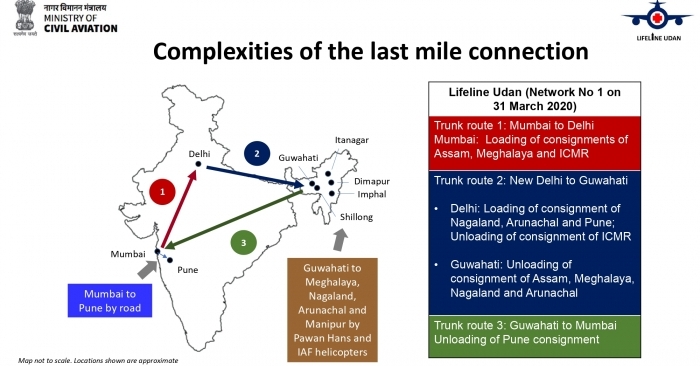Ministry of Civil Aviation ready with war room to fight against Covid-19
April 3, 2020: Ministry of Civil Aviation (MoCA) has set up a war room to control the movement of critical and essential medical goods across the country to fight against Covid-19 pandemic under the Lifeline Udan programme.

April 3, 2020: Ministry of Civil Aviation (MoCA) has set up a war room to control the movement of critical and essential medical goods across the country to fight against Covid-19 pandemic under the Lifeline Udan programme.
Till April 1, within seven days the war room facilitated the movement of 76 tonnes cargo using 85 flights covering 93,000 km across the country. The ministry used 62 flights of Air India & Alliance Air and 15 of Indian Air Force (IAF) with a particular focus on northeastern states, islands and hilly areas in the country, where other modes of transport may fail to reach on time.
The ecosystem which has been put in place to deal with the current crisis, is up & running.
— Hardeep Singh Puri (@HardeepSPuri) April 2, 2020
62 flights of @airindiain & Alliance Air & 15 flights of @IAF_MCC have already transported 76 tonnes of critical medical supplies transversing 93k kms across the country. pic.twitter.com/7r6qkSL7ad
A typical day in the war room
MoCA coordinates with state governments, Airport Authority of India, airports, airlines, IAF and private helicopters to move these vital cargoes. A typical day in the war room involves stocktaking video conference at 8 am, listing consignment requirements of states for the next day till 2 pm, network planning through video conference at 3 pm, finalising the flight schedules with airlines at 5 pm and final adjustments & progress update till 8 pm.
Challenges during the war
The ministry also reports challenges including the light density of cargo, production delays, restriction in movement of staff, difficult weather conditions, changes in flight schedules and lack of local coordination.
Online portal to connect
The war room is also running a Lifeline Udan portal developed by National Informatics Centre (NIC) in just three days. The easy to use and navigate portal helps states and UTs to upload required consignment data, airlines to fill flight options available, MoCA to plan and coordinate the network and simultaneously produce daily updates for the public.
The hub and spoke model network
The war room has adopted a hub and spoke model where metros like Delhi, Mumbai, Chennai, Kolkata, Bengaluru and Hyderabad used as hubs while state capitals and remote regions as spokes.
As of now, the network has fixed three trunk routes between these hubs and spokes for easy movement of goods.
Trunk route 1 is from Mumbai to Delhi, for which the financial capital is used for loading consignments for Assam, Meghalaya and the Indian Council of Medical Research (ICMR).
Trunk route 2 is from Delhi to Guwahati. On this path, the hub in Delhi loads consignments for Nagaland, Arunachal Pradesh and Pune while also unloading the goods for ICMR. Guwahati, which provides last-mile connectivity using IAF and Pawan Hans helicopters, unload cargoes for Assam Meghalaya, Nagaland and Arunachal Pradesh.
Trunk route 3 is from Guwahati to Mumbai as a passage for the consignments to Pune.

Libin Chacko Kurian
Assistant Editor at STAT Publishing Group, he has eight years of experience in business journalism covering food & beverage, nutraceuticals and now logistics. His current passion is to understand the nuances of global supply chains and their current turmoil. Outside work, he is also interested in philosophy, history, birding and travelling. Mail him: libin@statpublishinggroup.com Follow on LinkedIn



_page-0001.jpg.jpg)